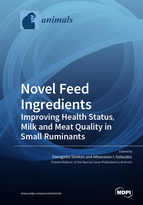Novel Feed Ingredients: Improving Health Status, Milk and Meat Quality in Small Ruminants
A special issue of Animals (ISSN 2076-2615). This special issue belongs to the section "Small Ruminants".
Deadline for manuscript submissions: closed (31 December 2022) | Viewed by 30417
Special Issue Editors
Interests: milk quality; dietary antioxidants; animal welfare
Special Issues, Collections and Topics in MDPI journals
Interests: veterinary epidemiology; animal infectious and parasitic diseases; herd health management; zoonoses; food-borne pathogens; One Health; farm animal husbandry; mastitis; lameness; small ruminant lentiviruses
Special Issues, Collections and Topics in MDPI journals
Special Issue Information
Dear Colleagues,
Alternative feeding approaches are continuously evaluated in small ruminant production systems in an effort to fortify animal health and welfare, improve milk and meat quality, prolong their shelf life and increase their marketable value. Incorporation of novel feed ingredients into small ruminants’ diets has therefore emerged as an effective strategy for the enhancement of milk and meat intrinsic quality since bioactive compounds are preferably deposited where they are mostly required. Dietary supplementation with these novel additives could manipulate bacteria involved in ruminal biohydrogenation, decrease methane emissions, enhance animals’ health and well-being status, reinforce antioxidant and anti-spoilage properties and positively modify milk and meat quality characteristics.
The aim of this Special Issue is to present original research and reviews on the effects of novel feed ingredients and their bioactive compounds on health and welfare status, as well as milk and meat intrinsic quality of small ruminants.
Dr. Panagiotis Simitzis
Dr. Athanasios I. Gelasakis
Guest Editors
Manuscript Submission Information
Manuscripts should be submitted online at www.mdpi.com by registering and logging in to this website. Once you are registered, click here to go to the submission form. Manuscripts can be submitted until the deadline. All submissions that pass pre-check are peer-reviewed. Accepted papers will be published continuously in the journal (as soon as accepted) and will be listed together on the special issue website. Research articles, review articles as well as short communications are invited. For planned papers, a title and short abstract (about 100 words) can be sent to the Editorial Office for announcement on this website.
Submitted manuscripts should not have been published previously, nor be under consideration for publication elsewhere (except conference proceedings papers). All manuscripts are thoroughly refereed through a single-blind peer-review process. A guide for authors and other relevant information for submission of manuscripts is available on the Instructions for Authors page. Animals is an international peer-reviewed open access semimonthly journal published by MDPI.
Please visit the Instructions for Authors page before submitting a manuscript. The Article Processing Charge (APC) for publication in this open access journal is 2400 CHF (Swiss Francs). Submitted papers should be well formatted and use good English. Authors may use MDPI's English editing service prior to publication or during author revisions.
Keywords
- Novel feed ingredients
- Bioactive compounds
- Antioxidants
- Dietary additives
- Health status
- Welfare
- Milk quality
- Meat quality
- Microbial spoilage
- Qxidation








